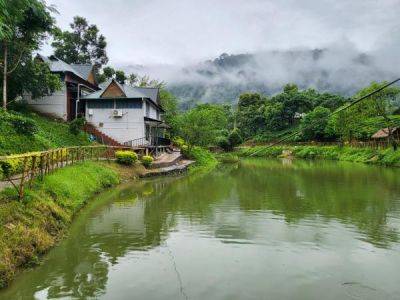

Agnigarh, which translates to 'fortress of fire', is a hill on the banks of the Brahmaputra River in Tezpur, Assam. This site offers a blend of mythology and scenic beauty. According to legend, it was the site where King Banasura kept his daughter Usha in isolation. The hill provides a panoramic view of the Brahmaputra River and the Tezpur town. There is a beautiful garden and sculptures depicting the love story of Usha and Aniruddha, Lord Krishna's grandson. Visitors can stroll through the pathways, enjoy the well-maintained gardens, and learn about the historical and mythological significance of the site. It's a place to immerse yourself in Assam's rich folklore while taking in the breathtaking views.
Tezpur is surrounded by lush tea gardens that are a hallmark of Assam's legacy in tea production. Taking a tour of a tea estate, you can learn about the intricate process of tea making – from plucking leaves to the final packaging. These tours often include a walk through the tea bushes, watching the tea plucking, a visit to the factory and insight into the fermentation, drying, and grading processes. Indulge in some tea tasting sessions to distinguish between different flavors. The experience is not just educational but also sensory, as the fragrance of fresh tea leaves surrounds you and the greenery soothes your eyes.
Nameri National Park is a haven for wildlife enthusiasts and a vital part of Assam's rich biodiversity, located about 35 km from Tezpur. The park is home to various species, including the rare white-winged wood duck, elephants, and tigers. Embark on a safari through the dense forests to witness these animals in their natural habitat or enjoy river rafting on the Jia Bhoroli River. The park is also a popular destination for bird watchers as it houses over 300 species of birds. Visitors require permission from the forest department to enter, and it's advisable to hire a local guide to make the most out of your visit to this biodiversity hotspot.
Chitralekha Udyan, also known as Cole Park, is a beautiful and well-maintained park in the heart of Tezpur. With its serene lakes, ancient ruins, and well-kept gardens, the park offers a pleasant escape from the city's bustle. Attractions include stone sculptures that date back to the 9th century and a pair of massive stone pillar bases known as Bamuni Hills. Visitors also find paddle boats to enjoy the lake. The park has a toy train, which is a hit among children, and ample spots perfect for picnics. Spending time here is relaxing, a chance to connect with nature and history simultaneously.
Da-Parbatia is a doorstep to history, showcasing the ancient ruins of the temple with elaborate carvings that stand as testimony to the architectural brilliance of ancient Assam. Located close to Tezpur, the temple ruins date back to the 6th century and are believed to be one of the earliest Hindu stone temples of Assam. The carvings feature floral designs and figures, hinting at the transition period between the Gupta and the Ahom styles of architecture. Though only a door frame remains of the original structure, it's a significant archaeological site for enthusiasts looking to delve into the past and explore the region's rich cultural heritage.
The Mahabhairab Temple stands tall as an embodiment of Shiva's divine presence in Tezpur. Believed to be established by King Banasura in the pre-historical times, the temple boasts a powerful shivling, attracting devotees throughout the year. The site has undergone several renovations over centuries but has maintained its spiritual significance. Pilgrims flock here during Shivratri and other auspicious days dedicated to Lord Shiva. Visiting this temple not only offers spiritual solace but is also a chance to witness the architectural and cultural evolution of temples in Assam.
Kalia Bhomora Setu is a remarkable feat of engineering that spans the mighty Brahmaputra River near Tezpur. This pre-stressed concrete road bridge connects Sonitpur on the north bank with Nagaon District on the south. It's named after the Ahom general Kalia Bhomora Phukan. Visitors can enjoy spectacular views of the river, especially during sunset or sunrise. The bridge also serves as a vantage point for observing riverine ecology and surrounding landscapes. While stopping on the bridge is not advised due to safety regulations, the approach roads offer ample opportunities for panoramic photography and sightseeing.
Bamuni Hills is synonymous with the ancient architectural finesse prevalent in Assam's history. Featuring the ruins from the 9th century, the hills have historically significant carvings and inscriptions on the walls of the temple remains. Although the temple is in ruins, the intricate carvings, motifs, and sculptures illustrate the stories from the past and offer insights into the life and beliefs of the people from those times. Nestled within lush greenery, this historical site in Tezpur is a great spot for archaeology aficionados and those looking to unwind amidst remnants of a bygone era.
Hazarapar Park is a public park with a small lake located in Tezpur, perfect for an evening stroll or a leisurely picnic with family and friends. The park has vast green lawns, shady trees, and a pathway around the lake. Visitors can enjoy boat rides on the lake and indulge in snacks from the nearby food stalls. The ambience is generally calm, making it an ideal spot for relaxation and photography. It is especially popular among locals as an escape from the urban environment and is a great way to experience the tranquility that Tezpur offers.
Situated in the heart of Tezpur, the District Museum showcases the rich cultural heritage and history of the Sonitpur district. The museum's collection includes relics, archaeological artifacts, and displays that narrate the story of the local tribes and the evolution of the region through different eras. Visitor can view traditional Assamese garments, pottery, coins, stone inscriptions, and sculptures that provide a deeper understanding of the area's past. This museum is perfect for history buffs and those curious about Assam's diverse cultural fabric.
